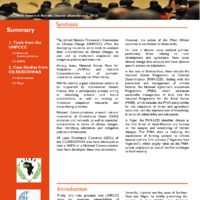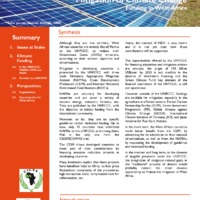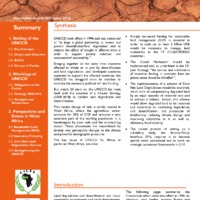Recherche
3 items
Climate change responses from west african states
The United Nations Framework Convention on Climate Change (UNFCCC) offers the developing countries some tools to evaluate their vulnerabilities to climate changes, to plan and to implement adaptation and mitigation policies and measures. Among them, National Action Plans for Adaptation (NAPAs) and National Communications are of particular importance, especially for West Africa. NAPAs identify urgent adaptation actions to be supported by international climate finance, after a participatory process aiming at identifying present and future vulnerabilities, as well as existing or innovative adaptation measures, and hierarchizing priorities. National Communications present national inventories of Greenhouse Gases (GHG) emissions and removals, as well as countries’ vulnerabilities in terms of climate changes, thus identifying adaptation and mitigation policies and measures. All Least Developed Countries (LDCs) of the CILSS/ECOWAS area have developed at least a NAPA or a National Communication; most have developed these two documents. However, the action of the West African countries is not limited to these tools. For over a decade, many national policies, particularly those relating to rural development and agriculture, have taken climate change into account and have planned specific actions on adaptation. In the case of Burkina-Faso, these include the National Action Programme to Combat Desertification (PAN-LCD), dealing with the prevention and management of climate hazards, the National Agriculture Investment Programme (PNIA) which addresses sustainable management of land, and the National Programme for the Rural Sector (PNSR), which includes the PNIA and provides for the adaptation of forest and agricultural resources, and the improvement of knowledge in terms of vulnerability and adaptation. In Niger, the PAN-LCD identifies climate as the first driver of desertification and focuses on the analysis and monitoring of climate changes. The PNIA aims at reducing the dependence of farming systems to climate hazards and the 3-N initiative ("Nigeriens feed Nigeriens"), which largely relies on the PNIA, quotes adaptation as one of the five challenges to food security.
Mitigation of climate change funding in west africa
Although they are low emitters, West African countries are invited, like all Parties to the UNFCCC, to reduce their Greenhouse Gases (GHGs) emissions, according to their national capacities and circumstances. Mitigation in developing countries is promoted by the UNFCCC with three tools: Nationally Appropriate Mitigation Actions (NAMAs), Clean Development Mechanism (CDM), and Intended Nationally Determined Contributions (INDCs). NAMAs are voluntary for developing countries and can cover a variety of sectors: energy, transport, forestry, etc. They are published by the UNFCCC, with the objective to attract funding from the international community. However, so far, they are no specific guidelines neither dedicated funding. Up to now, only 15 countries have submitted NAMAs to the UNFCCC, and among them, Mali is the only one from the CILSS/ECOWAS area. The CDM allows developed countries to meet part of their commitments by financing emission reduction projects in developing countries. Many limitations explain that these projects have benefited little to Africa: carbon price fluctuations, complexity of the procedures, high transaction costs, complicated rules for reforestation, etc. Finally, the concept of INDC is very recent and it is not yet clear how these contributions will be supported. The opportunities offered by the UNFCCC for financing adaptation and mitigation actions are tenuous: the target of 100 billion US$/year by 2020 is not credible in the absence of short-term financing and the Green Climate Fund, key element of the financial mechanism of the UNFCCC, is still not operational. However, outside of the UNFCCC, fundings are available for mitigation, especially in the agriculture and forest sectors: Forest Carbon Partnership Facility (FCPF), Forest Investment Programme (FIP), Global Alliance against Climate Change (GCCA), International Climate Initiative of Germany (ICI), and Japan Initiative for Fast-Start Actions. In the short term, the West African countries could better benefit from the CDM, by advocating for its adaptation to their national circumstances, as well as from the NAMAs, by requesting the development of guidelines and dedicated funding. In the medium and long term, in the absence of tangible prospects under the UNFCCC, the integration of mitigation-related goals in the "traditional" projects of donors would probably remain the most obvious opportunity to finance the mitigation in West Africa.
United nations convention to combat desertification (UNCCD) : State of play and perspectives for west africa
UNCCD took effect in 1996 and was conceived of "to forge a global partnership to reverse and prevent desertification/land degradation and to mitigate the effects of drought in affected areas in order to support poverty reduction and environmental sustainability." Bringing together at the same time countries affected in whole or in part by desertification and land degradation, and developed countries expected to support the affected countries, the UNCCD has struggled since its creation to mobilise the necessary political will and funding. But, nearly 20 years on, the UNCCD has reset itself with the adoption of a 10-year Strategy (2008-2018) to combat land degradation and desertification. This recent change of tack is sorely needed in West Africa, where the agricultural sector accounts for 35& of GDP and occupies a very extensive part of the working population. It is handicapped by poor soils and the encroaching desert. These phenomena are exacerbated by already very perceptible changes to the climate and powerful demographic pressures. The key issues of UNCCD for Africa, in particular West Africa, are clear: Introduction Land degradation and desertification are major constraints to economic and social development. Inspired by that realisation, African, Latin American, and Mediterranean leaders called into being the UN Convention to Combat Desertification (UNCCD). Translation: Peter Gaechter, SOS Sahel Sharply increased funding for sustainable land management (SLM) is essential in order to scale up: at least 2 billion US$ would be necessary to manage land sustainably in the 17 CILSS/CEDEAO countries ; The Global Mechanism should be implemented and, as underlined in the 10year Strategy, “the sources and mechanisms of innovative funding, in particular from the private sector should be identified ”; The implementation of a scheme of Zero Net Land Degradation should be explored, which aims at compensating degraded land by an equal quantity of restored land and to achieve a balance. Indeed, this scheme would allow degraded land to be restored and contribute to combating degradation and desertification, the protection of biodiversity, reducing climate change, and improving adaptation to it, as well as, obviously, food security; The recent process of setting up a subsidiary body, the Science-Policy Interface (SPI), requires it to become quickly more operational and to work on strategic investment frameworks in SLM.


